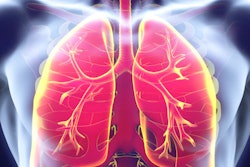
Lung nodules found on follow-up CT lung screening rounds could be more dangerous than those found on baseline exams, according to a new analysis of data from the National Lung Screening Trial (NLST). The findings are published in the November issue of the American Journal of Roentgenology.
The lung cancer risk associated with new nodules was significantly higher than the risk from nodules discovered on baseline screening exams, lead author Dr. Paul Pinsky from the U.S. National Institutes of Health (NIH) told AuntMinnie.com in an email. Other study findings also indicate that not all nodules should be treated equally.
"New nodules need to be managed and evaluated differently from baseline nodules, and the specific lung cancer risks associated with new nodules of varying sizes need to be taken into account," he said.
Old trial, new nodules
In the NLST, low-dose CT was used to screen more than 25,000 current or former smokers at high risk for lung cancer. Approximately 24,000 of those patients returned for follow-up screenings after one or two years, with a 2% to 3% incidence of new solid nodules per year appearing on follow-up low-dose CT examinations.
In a similar fashion, other large-scale CT lung cancer screening projects, including the Dutch-Belgian Randomized Lung Cancer Screening (NELSON) trial, the Mayo Clinic study, and the International Early Lung Cancer Action Program (I-ELCAP), reported new nodules in 5% to 13% of participants per annual follow-up screen (AJR, November 2017, Vol. 209:5, pp. 1009-1014).
On average, these separate studies associated new nodules with a 5% increased risk of lung cancer, according to the researchers. The NELSON trial also reported that larger nodule size corresponded to increased cancer risk.
Although the NLST provided results for two postbaseline CT screening rounds, the published analyses did not distinguish between pre-existing and new nodules the way other trials did. To fill that gap, Pinsky and colleagues collaborated with the U.S. National Cancer Institute to investigate the frequency and size distribution of new solid nodules in the NLST and their correlation to the risk of developing lung cancer.
"We wanted to see if the NELSON trial results would be reproduced in the U.S. NLST trial," Pinsky said.
The group specifically focused on investigating the relationship between nodule size and cancer characteristics such as histologic findings, stage, and survival. The longest diameter of each nodule determined its size.
The median age of the participants was 60 years; 59% were men, and 47% were smokers at the time of screening.
Bigger isn't better
At the first NLST low-dose CT lung cancer screening, 21.3% of participants presented with at least one nodule. Among those participants, 2.6% had at least one new solid nodule at either the one-year or two-year postbaseline screening.
Among the 1,654 new nodules detected, 94 were found to be cancer. These newly detected solid nodules were associated with lung cancer based on their size, the researchers found.
| Correlation between new nodule size and cancer in NLST | |
| Mean diameter of nodule (mm) | Nodules linked to cancer |
| < 4 | 1.1% |
| 4 to < 6 | 2.3% |
| 6 to < 8 | 5.4% |
| 8 to < 10 | 6.4% |
| 10 to < 15 | 13.8% |
| 15 to < 20 | 19.4% |
| ≥ 20 | 24% |
For the new solid nodules, the cancer rate increased markedly along with increases in nodule size. Lee et al reported a comparable finding among subsolid nodules, i.e., that nodule size was a predictor of malignancy.
Relative to the initial set of nodules, the small new nodules displayed a stronger tendency to lead to cancer. More specifically, new solid nodules 4 mm to 8 mm in size had a significantly higher cancer rate, at 7.7%, compared with 1.7% for similarly sized nodules found at baseline (p < 0.001). On the other hand, new solid nodules at least 20 mm in size had a significantly lower cancer rate, at 24%, compared with 41% for similarly sized nodules found at baseline (p = 0.03).
The researchers also noted that cancers linked to new nodules versus baseline nodules were significantly less likely to be adenocarcinoma (25.6% versus 61%; p < 0.001) and more likely to be small cell lung cancer (17.4% versus 3.9%; p < 0.001).
Moreover, the five-year survival rate of people with cancer linked to baseline nodules was 66.6%, a number that fell to 51.1% for nodules detected on follow-up rounds (p = 0.001).
"Lung cancers linked to new nodules had significantly worse survival than those linked to baseline nodules," Pinsky said.
How does the NLST compare?
The researchers acknowledged that the primary limitation of their study was associating cancer risk and new nodules based on location, as there was no means of directly linking cancers to particular nodules.
Another issue was the different parameters they used to measure nodule size compared to other studies. For example, the NLST determined the size of nodules according to their largest diameter, whereas the NELSON trial tracked their volume.
Nonetheless, a comparison of the incidence rate of new solid nodules and their lung cancer rate in several different studies demonstrates notable similarities.
| Lung cancer risk of new nodules in various studies | ||||
| Mayo Clinic | I-ELCAP | NELSON | NLST | |
| Incidence of new nodules | 13% | 5.3% | 5.9% | 2.6% |
| New nodules linked to lung cancer | 1.5% | 5.1% | 4.2% | 5.7% |
Despite finding the lowest percentage of new nodules upon follow-up CT screening, the NLST reported a higher rate of new nodules linked to lung cancer than the other trials.
What rings true in the NLST as well as various other trials is that the risks associated with new nodules may be different from those associated with baseline nodules -- overall and within each size category, Pinsky told AuntMinnie.com.
The future direction is to pursue "longer-term follow-up of new nodules to see how they transition to lung cancer over time," he said.




















